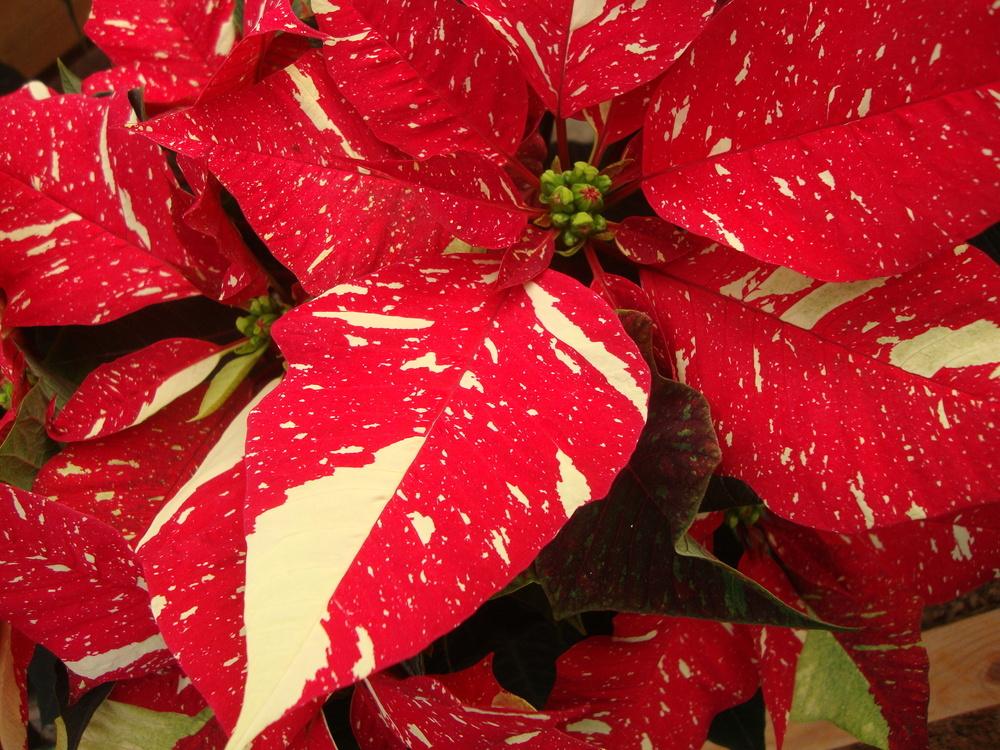Poinsettias are a strange plant, different from almost anything we purposely grow. It has a highly unusual beauty, with colorful bracts being the main focal point, brought on by a curious ritual of alternating light and darkness. It is poisonous and, other than its ornamental nature, isn't particularly useful, but it does bring a beauty and color at a time of year when little else is growing, and that makes it the most popular December garden purchase in the country. Let's learn some things about poinsettias, so that at Christmas get-togethers this year we can be the life of the party by sharing interesting facts with friends, family and co-workers.

The "African Milk Tree" is a houseplant sold at big box stores. It's fairly tall, has thorns, makes leaves, and can be propagated like a cactus, but it's not; it's a spurge! Also in this genus, found all throughout the Texas Hill Country, is "Snow on the Mountain," which, if you think about it, does resemble a poinsettia! The Pencil Cactus and Crown of Thorns are also both Euphorbias. If you ever notice a weed in your garden that looks just like a poinsettia, well, you have Euphorbia cyathophora, which is called "Wild Poinsettia" and grows native in East Texas.
Poinsettia (Euphorbia pulcherrima) is the plant we're talking about this month, though. It was introduced to the US in the early 1800s by the American ambassador to Mexico, a Mr. Joel Poinsett, from whom it also got its common name. Like the other spurges, it is highly drought tolerant and is simple to care for. Also, like many other spurges, its beauty is found in its bracts rather than its blooms.
So, what's a bract? It's a leaf-like structure on a plant, that looks like a leaf, but it is not. The "blooms" on a bougainvillea are, in fact, bracts. If you look at the center of the bracts, you will see the actual little blooms. Sunflowers and daisies grow bracts. If you look at the flower heads, you'll see the green leaf-like things around the blooms, and those are bracts. Bracts perform a variety of useful functions, but the most ornamental ones seem to be designed to attract pollinators with their striking colors.

Enjoy the plant through Christmas time, and once you're on the other side of the season, it'll start to go dormant. This is the point when most people throw it out, but we're gardeners and we can't bear the thought of throwing away a live plant, so let's have some fun and keep growing it. Keep caring for it as usual, giving it plenty of light and watering as usual. As we get into springtime, slow down the watering and let it stay dry for longer periods of time. When the stems start to shrivel up a little bit, go ahead and cut the whole plant back to just a few inches, and store it somewhere cool.
Starting in mid summer, take it out, submerge it in a bucket of water, wash off as much of the old soil as you can, and then repot it into the same container using nice fresh potting soil. Put it on your shady porch, water it, give it some nice fertilizer (I like vermicompost tea) and treat it like you would any other potted plant. As it grows, pinch the stems to encourage branching.
Now here's the interesting part. When you get to early October, you need to trick it into producing the colored bracts, and you do that by giving it alternating darkness and light. So at 5:00pm put it in an absolutely dark closet, and then at 8:00am bring it back out into the light. Do this each day, and the plant will soon think it's the time of year to "flower" and will start producing those snazzy red bracts. A gardener feels a great sense of accomplishment in forcing a poinsettia, and I recommend everyone do it at least once, if only for the fun experience.
After reading about this, I know you're now curious about the Euphorbia genus. We have a huge database of euphorbias here at ATP, and you can view it by going to The Euphorbias Databaseand while there, you can see photos and post comments about your own experiences with this broad genus of interesting plants.Convert to